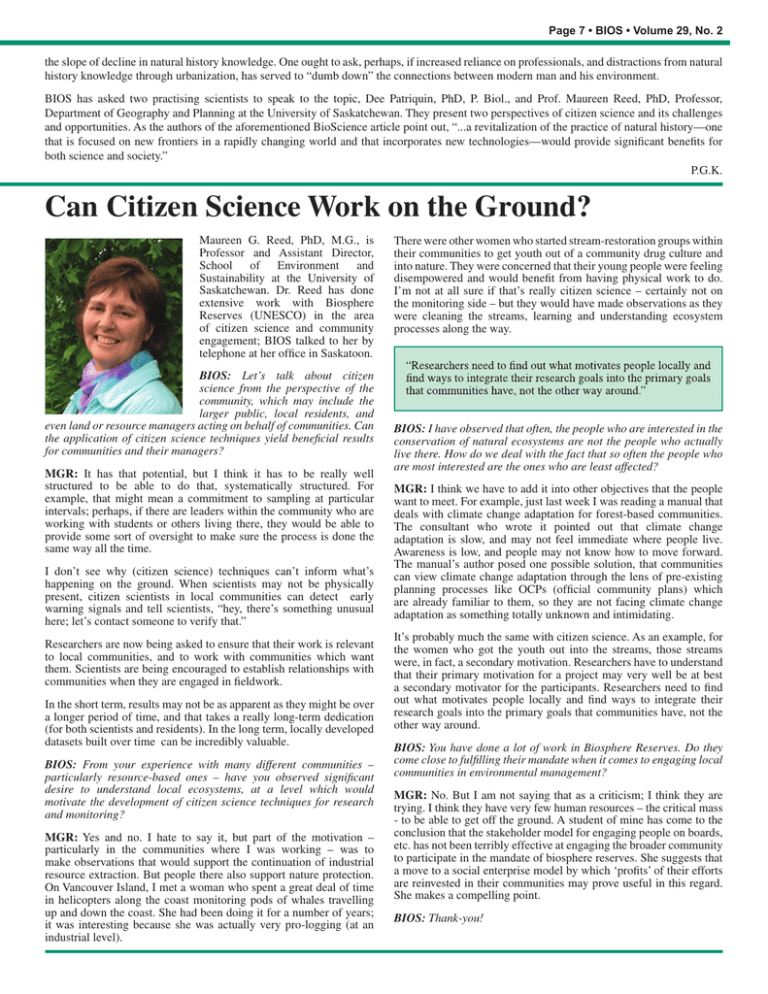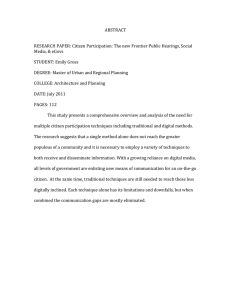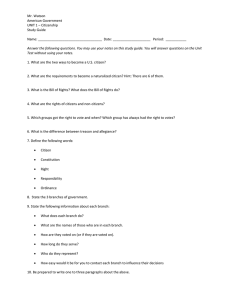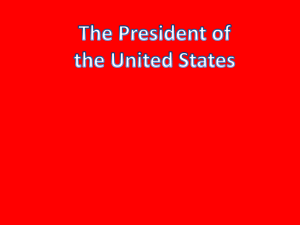Maureen G. Reed, PhD, M.G., is Professor and Assistant Director,
advertisement

Page 7 • BIOS • Volume 29, No. 2 the slope of decline in natural history knowledge. One ought to ask, perhaps, if increased reliance on professionals, and distractions from natural history knowledge through urbanization, has served to “dumb down” the connections between modern man and his environment. BIOS has asked two practising scientists to speak to the topic, Dee Patriquin, PhD, P. Biol., and Prof. Maureen Reed, PhD, Professor, Department of Geography and Planning at the University of Saskatchewan. They present two perspectives of citizen science and its challenges and opportunities. As the authors of the aforementioned BioScience article point out, “...a revitalization of the practice of natural history—one that is focused on new frontiers in a rapidly changing world and that incorporates new technologies—would provide significant benefits for both science and society.” P.G.K. Can Citizen Science Work on the Ground? Maureen G. Reed, PhD, M.G., is Professor and Assistant Director, School of Environment and Sustainability at the University of Saskatchewan. Dr. Reed has done extensive work with Biosphere Reserves (UNESCO) in the area of citizen science and community engagement; BIOS talked to her by telephone at her office in Saskatoon. BIOS: Let’s talk about citizen science from the perspective of the community, which may include the larger public, local residents, and even land or resource managers acting on behalf of communities. Can the application of citizen science techniques yield beneficial results for communities and their managers? MGR: It has that potential, but I think it has to be really well structured to be able to do that, systematically structured. For example, that might mean a commitment to sampling at particular intervals; perhaps, if there are leaders within the community who are working with students or others living there, they would be able to provide some sort of oversight to make sure the process is done the same way all the time. I don’t see why (citizen science) techniques can’t inform what’s happening on the ground. When scientists may not be physically present, citizen scientists in local communities can detect early warning signals and tell scientists, “hey, there’s something unusual here; let’s contact someone to verify that.” Researchers are now being asked to ensure that their work is relevant to local communities, and to work with communities which want them. Scientists are being encouraged to establish relationships with communities when they are engaged in fieldwork. In the short term, results may not be as apparent as they might be over a longer period of time, and that takes a really long-term dedication (for both scientists and residents). In the long term, locally developed datasets built over time can be incredibly valuable. BIOS: From your experience with many different communities – particularly resource-based ones – have you observed significant desire to understand local ecosystems, at a level which would motivate the development of citizen science techniques for research and monitoring? MGR: Yes and no. I hate to say it, but part of the motivation – particularly in the communities where I was working – was to make observations that would support the continuation of industrial resource extraction. But people there also support nature protection. On Vancouver Island, I met a woman who spent a great deal of time in helicopters along the coast monitoring pods of whales travelling up and down the coast. She had been doing it for a number of years; it was interesting because she was actually very pro-logging (at an industrial level). There were other women who started stream-restoration groups within their communities to get youth out of a community drug culture and into nature. They were concerned that their young people were feeling disempowered and would benefit from having physical work to do. I’m not at all sure if that’s really citizen science – certainly not on the monitoring side – but they would have made observations as they were cleaning the streams, learning and understanding ecosystem processes along the way. BIOS: I have observed that often, the people who are interested in the conservation of natural ecosystems are not the people who actually live there. How do we deal with the fact that so often the people who are most interested are the ones who are least affected? MGR: I think we have to add it into other objectives that the people want to meet. For example, just last week I was reading a manual that deals with climate change adaptation for forest-based communities. The consultant who wrote it pointed out that climate change adaptation is slow, and may not feel immediate where people live. Awareness is low, and people may not know how to move forward. The manual’s author posed one possible solution, that communities can view climate change adaptation through the lens of pre-existing planning processes like OCPs (official community plans) which are already familiar to them, so they are not facing climate change adaptation as something totally unknown and intimidating. It’s probably much the same with citizen science. As an example, for the women who got the youth out into the streams, those streams were, in fact, a secondary motivation. Researchers have to understand that their primary motivation for a project may very well be at best a secondary motivator for the participants. Researchers need to find out what motivates people locally and find ways to integrate their research goals into the primary goals that communities have, not the other way around. BIOS: You have done a lot of work in Biosphere Reserves. Do they come close to fulfilling their mandate when it comes to engaging local communities in environmental management? MGR: No. But I am not saying that as a criticism; I think they are trying. I think they have very few human resources – the critical mass - to be able to get off the ground. A student of mine has come to the conclusion that the stakeholder model for engaging people on boards, etc. has not been terribly effective at engaging the broader community to participate in the mandate of biosphere reserves. She suggests that a move to a social enterprise model by which ‘profits’ of their efforts are reinvested in their communities may prove useful in this regard. She makes a compelling point. BIOS: Thank-you!








